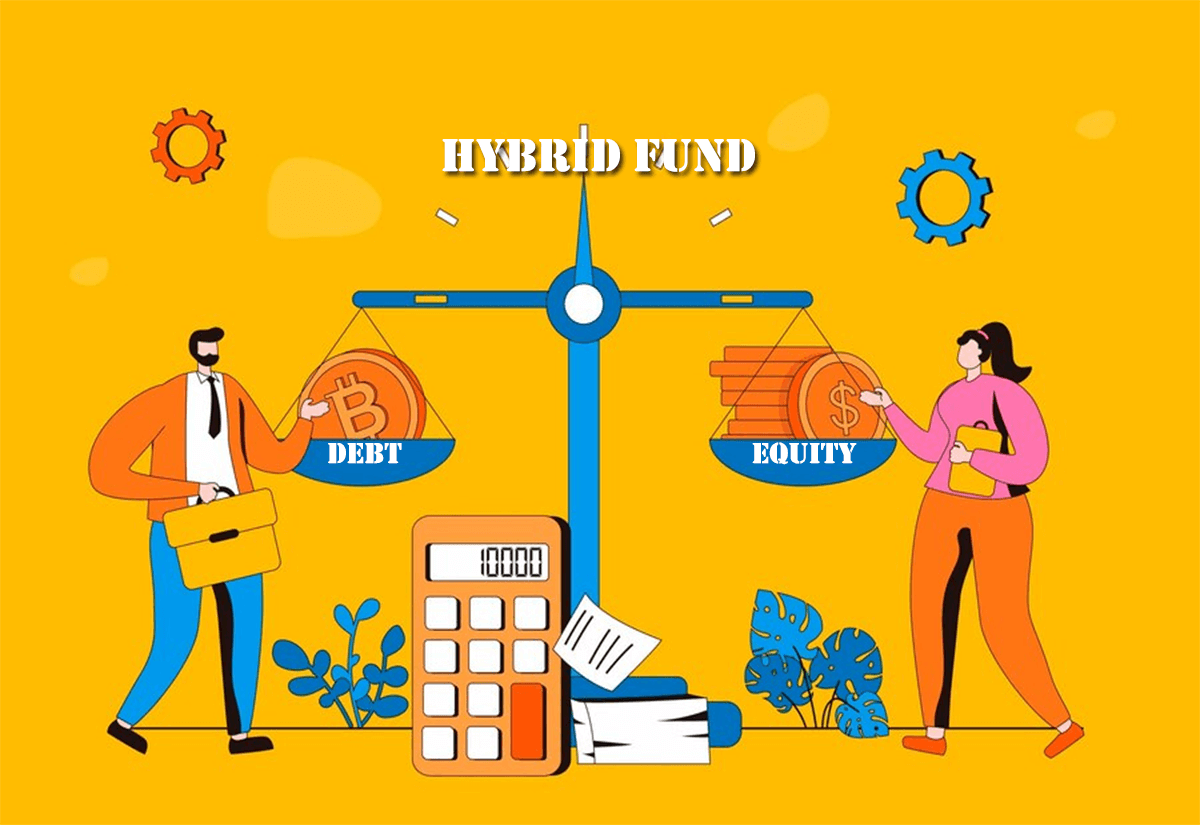What's Inside?
- What is Hybrid Funds?
- How Does a Hybrid Fund Work?
- Types of Hybrid Funds
- Features of Hybrid Funds
- Advantages and Disadvantages of Hybrid Funds
- Tax Details of Hybrid Funds
- Who Should Invest in Hybrid Funds?
- How to Choose the Right Hybrid Fund?
- Top mistakes to avoid while investing in Hybrid funds
- Frequently Asked Questions (FAQs)
- What are hybrid funds?
- How do conservative hybrid funds work?
- What are balanced hybrid funds?
- What are dynamic asset allocation funds?
- What are the advantages of investing in hybrid funds?
- Are hybrid funds suitable for beginners?
- How can I invest in hybrid funds?
- What are the factors to consider before investing in hybrid funds?
In today’s ever-evolving investment landscape, finding the right investment vehicle that offers a balance of risk and reward can be a daunting task. Hybrid funds, a unique category in the realm of mutual funds, have emerged as a popular choice for investors seeking diversification and flexibility. By combining the characteristics of both equity and debt instruments, hybrid funds aim to provide a diversified portfolio that suits the risk appetite of various investors. Whether you are a conservative investor looking for stable returns or an aggressive investor seeking growth opportunities, understanding the intricacies of hybrid funds can help you unlock the potential of this investment avenue. Here we delve into the world of hybrid funds, exploring their features, types, benefits, and considerations to guide you on your investment journey.
What is Hybrid Funds?
Hybrid funds, sometimes referred to as balanced funds, represent a unique category within mutual funds. They blend characteristics from both equity and debt instruments, offering investors a diversified investment approach. These funds offer a diversified investment portfolio by investing in a mix of stocks and bonds. The objective of hybrid funds is to strike a balance between growth and stability, catering to different risk appetites of investors. By blending the potential for capital appreciation from equities and the income generation and stability of debt instruments, hybrid funds aim to provide investors with a well-rounded investment option. The allocation between equity and debt may vary based on the fund’s investment strategy, allowing investors to choose a hybrid fund that aligns with their financial goals and risk tolerance.
How Does a Hybrid Fund Work?
A hybrid fund is an investment vehicle that blends various asset types, usually including both stocks and bonds, within one portfolio. Here are some key points on how a hybrid fund works:
Asset Allocation: Hybrid funds aim to diversify investments by allocating funds across multiple asset classes, such as equities, fixed income, and cash equivalents.
Risk-Return Profile: The asset allocation of a hybrid fund determines its risk-return profile. Funds with a higher allocation to equities generally have higher growth potential but also higher risk, while funds with a higher allocation to fixed income provide more stability but lower potential returns.
Active Management: Hybrid funds are actively managed by professional fund managers who make investment decisions based on market conditions, economic outlook, and the fund’s investment objectives. They may adjust the portfolio’s asset allocation over time to capitalize on opportunities or manage risk.
Income Generation: Hybrid funds may generate income through dividends and interest payments from the underlying investments, such as stocks and bonds. This income is distributed to the fund’s investors periodically, usually on a monthly or quarterly basis.
Capital Appreciation: Hybrid funds aim for growth by putting money into stocks and other assets that tend to increase in value. As these investments grow, the fund’s net asset value (NAV) goes up, which could mean profits for investors in the form of capital gains.
Flexibility: Hybrid funds offer flexibility in adapting to changing market conditions. Fund managers can adjust the asset allocation based on their outlook, increasing or decreasing exposure to different asset classes as deemed appropriate.
Suitability for Different Investors: Hybrid funds cater to investors seeking a blend of growth opportunities and risk management. They’re typically viewed as moderate-risk choices, ideal for those with a medium-term investment outlook.
Investment Options: Hybrid funds come in various forms, such as balanced funds, dynamic asset allocation funds, and target-date funds. Each type has its own specific investment strategy and risk profile, catering to different investor preferences.
Fees and Expenses: Hybrid funds charge fees and expenses, including management fees, which are typically a percentage of the fund’s assets. These costs impact the fund’s overall performance and should be considered by investors.
Types of Hybrid Funds
There are several types of hybrid funds, each with its own investment strategy and asset allocation. Here are the common types of hybrid funds:
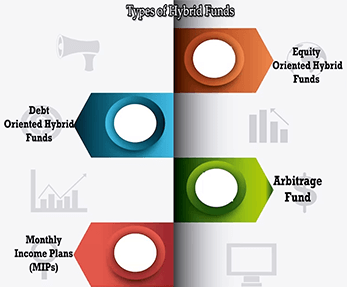
- Equity Oriented Hybrid Fund
An equity-oriented hybrid fund is a type of hybrid fund that primarily focuses on investing in equities or stocks. These funds typically have a higher allocation to equity securities compared to fixed-income securities. The objective of an equity-oriented hybrid fund is to provide investors with a combination of capital appreciation from equity investments and stability from fixed-income investments. While the specific allocation can vary, these funds generally aim to strike a balance between growth and income by investing in a diversified portfolio of stocks and bonds. The equity component of the fund can provide the potential for higher returns, while the fixed-income component can offer stability and income generation. Equity-oriented hybrid fund’s performance will be influenced by the performance of the equity markets and the specific securities held within the portfolio. - Debt Oriented Hybrid Fund
A debt-oriented hybrid fund, also known as a balanced fund, is a type of mutual fund or exchange-traded fund (ETF) that primarily invests in fixed-income securities such as bonds, while also allocating a smaller portion of its assets to equities or stocks. The main aim of a debt-oriented hybrid fund is to achieve dual goals: first, by earning income through fixed-income securities’ interest payments, and second, by targeting growth in capital through the equity portion. - Arbitrage funds
Arbitrage funds are a type of hybrid fund that aims to take advantage of price discrepancies or temporary mispricing between different financial instruments in the market. These funds typically engage in simultaneous buying and selling of securities in different markets or segments to exploit the price differentials. - Monthly Income Plans (MIPs)
Monthly Income Plans (MIPs) are a type of hybrid fund that primarily focuses on generating regular income for investors while also providing potential for capital appreciation. MIPs typically invest a significant portion of their assets in debt instruments such as bonds, debentures, and fixed deposits, which generate regular interest income. Additionally, they allocate a smaller portion of their assets to equities to potentially benefit from capital appreciation. The income generated from the debt portion is distributed to investors as regular monthly dividends or interest payments. MIPs are suitable for investors seeking a regular income stream with moderate risk exposure and the potential for some long-term growth.
Features of Hybrid Funds
Here are some of the features commonly associated with hybrid funds:
Balanced Approach: Hybrid funds take a balanced approach by investing in both stocks and bonds. This helps to balance the risk and potential returns of the investment.
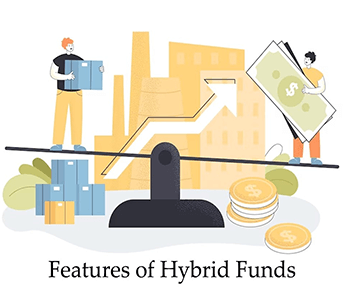
Investment Horizon: Hybrid funds are usually recommended for medium-term investments, typically ranging from 3 to 5 years.
Taxable Capital Gains: If you earn profits from your investment in hybrid funds, the tax you pay depends on how long you held the investment. Short-term gains are taxed differently from long-term gains.
Risk/Return: Hybrid funds carry a certain level of risk since they invest in both stocks and bonds. However, they are generally considered less risky than investing solely in stocks. On the other hand, they offer potentially higher returns compared to investing solely in bonds.
Advantages and Disadvantages of Hybrid Funds
Advantages:
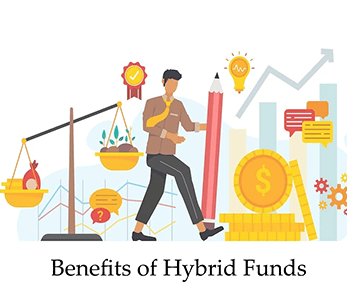
Diversification across asset classes.
Opportunities exist for generating income as well as increasing capital value.
Reduced volatility compared to pure equity funds.
Professional management by experienced fund managers.
Flexibility to adjust asset allocation based on market conditions.
Disadvantages:
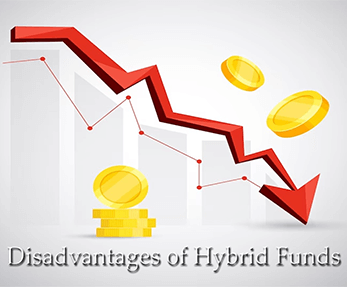
Equity funds offer higher potential returns than those with a mix of equity and other assets.
Higher expense ratios compared to some other investment options.
Limited control over asset allocation decisions.
Exposure to market risks of both equities and fixed-income securities.
Potential for underperformance during certain market conditions.
Tax Details of Hybrid Funds
The tax treatment of hybrid funds is contingent upon both the mix of assets they contain and how long those assets are held. Here are the tax details of hybrid funds in India:
Equity-Oriented Hybrid Funds: Hybrid funds that invest at least 65% of their total assets in equities are classified as equity-oriented funds for taxation purposes. The following tax rules apply:
- Short-term Capital Gains (STCG): If the holding period is less than one year, the gains are considered short-term and taxed at a flat rate of 15%.
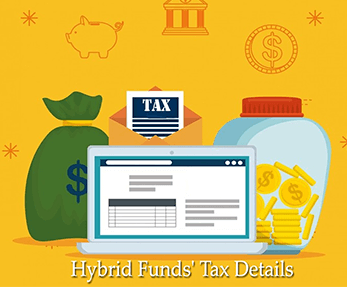 Long-term Capital Gains (LTCG): If the holding period is more than one year, the gains exceeding Rs 1 lakh in a financial year are taxed at 10% without indexation benefit.
Long-term Capital Gains (LTCG): If the holding period is more than one year, the gains exceeding Rs 1 lakh in a financial year are taxed at 10% without indexation benefit.
Debt-Oriented Hybrid Funds: Hybrid funds that have a higher allocation to debt instruments, such as bonds and fixed-income securities, are classified as debt-oriented funds. The following tax rules apply:
- Short-term Capital Gains (STCG): If the holding period is less than three years, the gains are treated as short-term and taxed at the investor’s applicable income tax slab rate.
- Long-term Capital Gains (LTCG): If the holding period is more than three years, the gains are taxed at 20% with indexation benefit or 10% without indexation benefit, whichever is lower.
Note: Indexation benefit allows adjusting the purchase price for inflation, which reduces the taxable capital gains.
Who Should Invest in Hybrid Funds?
Hybrid funds can be suitable for a range of investors based on their investment goals, risk tolerance, and time horizon. Below are various categories of investors who might contemplate investing in hybrid funds:
Moderate Risk Investors: Hybrid funds offer a balance between equities and fixed-income securities, making them suitable for investors with a moderate risk tolerance. These investors seek a combination of income generation and potential capital appreciation while managing downside risk.
Income-Oriented Investors: Hybrid funds can be appealing to investors who desire a regular income stream. The allocation to fixed-income securities in hybrid funds provides the potential for consistent income through interest payments or dividends.
Conservative Investors: For conservative investors seeking stability and capital preservation, conservative allocation hybrid funds may be a suitable option. These funds have a higher allocation to fixed-income securities, which can provide stability during market downturns.
Retirement Planning: Hybrid funds, particularly target date or lifecycle funds, can be beneficial for retirement planning. These funds automatically adjust the asset allocation over time, becoming more conservative as the target retirement date approaches, providing a systematic approach to managing risk while pursuing long-term growth.
Simplified Portfolio Management: Investors who prefer a simplified approach to portfolio management may find hybrid funds attractive. By investing in a single hybrid fund, they gain exposure to both equities and fixed-income securities without the need to manage individual investments.
First-Time Investors: Hybrid funds present an appealing choice for newcomers to investing, offering access to both equity and fixed-income markets without requiring in-depth investment expertise. This option provides diversification and expert management, making it a prudent way for beginners to start their investment journey.
How to Choose the Right Hybrid Fund?
Selecting the appropriate hybrid fund demands meticulous examination of numerous aspects. Here’s a step-by-step guide to help you choose the right hybrid fund:
Determine Investment Goals: Clearly define your investment objectives, whether it’s generating income, capital appreciation, or a combination of both. This will help you narrow down your options and choose a hybrid fund that aligns with your goals.
Assess Risk Tolerance: Evaluate your risk tolerance level, which will determine the appropriate allocation between equities and fixed-income securities. Conservative investors may prefer funds with a higher allocation to fixed-income securities, while more risk-tolerant investors may opt for funds with a higher equity exposure.
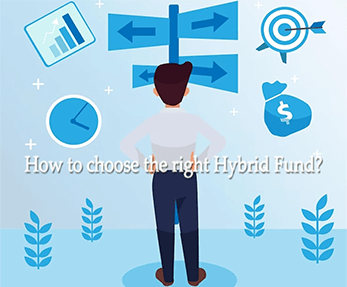
Understand Fund Types: Familiarize yourself with different types of hybrid funds, such as conservative allocation funds, aggressive allocation funds, balanced advantage funds, or target date funds. Each type has a specific asset allocation and investment strategy, and understanding their characteristics will help you select the most suitable option.
Analyze Past Performance: Examine the past performance of prospective hybrid funds across various time spans. Assess for steady performance and juxtapose their returns with applicable benchmarks and similar funds in the category. Nonetheless, bear in mind that previous performance does not guarantee future outcomes.
Evaluate Fund Manager: Assess the track record and experience of the fund manager. A skilled and experienced manager can make a significant difference in a fund’s performance. Research the manager’s investment approach, tenure, and their ability to navigate different market cycles.
Consider Expense Ratio: Examine the expense ratios of various hybrid funds and aim for those with lower expenses. Choosing funds with competitive expense ratios in their respective categories can enhance long-term returns.
Review Fund Holdings: Review the hybrid fund’s portfolio to grasp the mix of stocks, bonds, and other securities it holds. Evaluate whether these holdings match your investment preferences and risk tolerance.
Check Fund House Reputation: Evaluate the reputation and credibility of the fund house managing the hybrid fund. Look into the fund house’s history, corporate governance practices, and the range of investment options they offer.
Read the Fund’s Prospectus: Review the fund’s prospectus, which provides detailed information about the fund’s investment strategy, risks, expenses, and other essential details. It will help you understand the fund’s objectives and suitability for your investment needs.
Seek Professional Advice: If you are uncertain or inexperienced in selecting funds, consider seeking advice from a financial advisor who can provide personalized guidance based on your specific financial situation and goals.
Top mistakes to avoid while investing in Hybrid funds
When investing in hybrid funds, it’s important to avoid certain common mistakes to make informed investment decisions. Here are some top mistakes to avoid:
Neglecting Investment Objectives: Don’t invest in a hybrid fund without clearly defining your investment objectives. Understand whether you’re seeking income, capital appreciation, or a combination of both to select a suitable hybrid fund.
Ignoring Risk Profile: Evaluate your comfort level with risk and select a hybrid fund that matches it. If you lean towards a more conservative approach to risk, steer clear of aggressive allocation funds to prevent potential unease during market fluctuations.
Chasing Past Performance: Don’t solely rely on past performance when selecting a hybrid fund. Historical returns may not be indicative of future performance. Consider other factors such as fund strategy, risk management, and consistency of performance.
Overlooking Expense Ratios: Avoid ignoring the expense ratios of hybrid funds. Higher expense ratios can eat into your returns over time. Compare expense ratios across similar funds and choose funds with competitive expense ratios.

Focusing Solely on Dividends: If you’re investing in hybrid funds for income, don’t solely focus on high dividend yields. Consider the overall performance and growth potential of the fund. Dividend payments may fluctuate, and chasing high dividends could lead to suboptimal investment choices.
Overdiversification: Don’t spread your investments too thin by investing in too many hybrid funds. Owning several funds with similar asset mixes could duplicate your efforts and weaken potential gains. Instead, opt for a handful of high-quality hybrid funds that span various asset types.
Lack of Regular Monitoring: Don’t invest in hybrid funds and forget about them. Regularly monitor the performance of your investments, review fund holdings, and evaluate if they continue to align with your investment goals. Make adjustments if necessary.
Market Timing: Trying to time the market by frequently entering or exiting hybrid funds based on short-term market trends can be detrimental to your returns. Maintain a long-term investment approach and avoid making impulsive decisions based on market volatility.
Emotional Decision-making: Avoid making investment decisions based on short-term market sentiment or emotional reactions. Stick to your investment plan and avoid being swayed by temporary market fluctuations or market noise.
Lack of Professional Guidance: If you’re feeling uncertain about diving into hybrid funds or if you lack the necessary knowledge and expertise, it’s wise to refrain from moving forward without seeking professional advice. Engaging with a financial advisor can offer valuable perspectives and assist you in making well-informed investment choices.
In conclusion, hybrid funds have emerged as a powerful investment option, combining the best of both worlds in terms of risk and return. Their ability to adapt to changing market conditions and provide investors with a diversified portfolio makes them an attractive choice for those seeking a balanced investment approach. By blending the stability of bonds with the growth potential of equities, hybrid funds offer investors a unique opportunity to navigate the complexities of the financial markets. However, it is important for investors to carefully assess their risk tolerance and investment goals before considering hybrid funds. With proper due diligence and professional guidance, investors can harness the potential of hybrid funds to achieve their long-term financial objectives.

